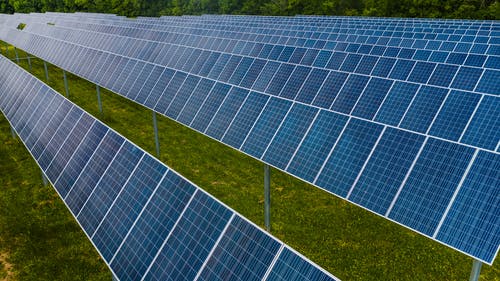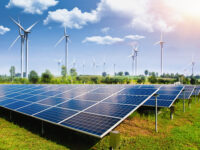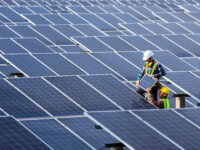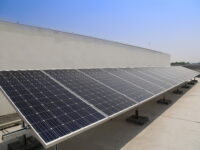It’s happening all over the country. Since 2008, this has been true. Across the nation, progressively, people are deciding to use the sun’s energy to power their homes and businesses. This has led to more and more solar panel being put up in homes and businesses. Adding a solar energy plot to the roof of your home may also be a good idea.
Solar panels for your photovoltaic system come in three main types: monocrystalline, polycrystalline, and thin-film. These are the three main types. These things have three main types: They all get their energy from the sun, but each has various characteristics that make it unique. The polycrystalline solar panel will be talked about in this piece of text. A closer look at it is going to be done right now. Keep reading the new blog in Linquip to learn more about what it has to say.
Also Read:
A polycrystalline solar panel contains several distinct types of crystals on it.
Polycrystalline or multi-crystalline solar panels have a lot of silicon crystals in a single PV cell, so they are called polycrystalline solar panels. Wafers made from polycrystalline solar panels are made by melting many pieces of silicon together until they form a single piece of silicon. For the vat of molten silicon used to make the cells cool down, it takes a long time. It stays on the screen itself while it does that.
Some solar panels have a surface that looks like a piece of art, but they do the job. When you look at these things, you can tell because they are polycrystalline silicon. They are square and have a very bright blue color. Polycrystalline panels have a lot of silicon crystals in each cell, which makes it hard for electrons to move around inside the cells. This makes it more difficult for the panels to work. Because of this, it takes longer to use the panels. Sun power is taken and turned into electricity with this type of solar cell.
A polycrystalline solar cell shows how it works.
People who make these panels have a lot of solar cells in their panels. This makes it possible to use electricity to make electricity because each cell is a semiconductor. One of the places where two N and P types of materials meet is called a “PN junction.” Light from the sun hits it, which gives electrons more energy to move as electricity and makes it move faster.
These materials are both P-type and N-type, but they’re not the same. These two types of materials are very different. P-type materials don’t have many electrons, while N-type materials have many electrons. When electricity is used in one of the PV cells, two electrodes are connected. Toward the top, there are wires. The foiled conductor is on the bottom.
Features of Polycrystalline Solar Panels
- Solar panels that don’t need to be individually shaped and placed are better for the environment than solar panels that do need to be individually shaped and put on the ground. Most of the silicon is used when making things. So, there’s very little waste.
- When it comes to polycrystalline solar panels, the temperature can get up to 85°C at the most. They can be as cold as -40°C.
- There are two kinds of solar panels: monocrystalline and polycrystalline. Polycrystalline solar panels can’t handle as much heat. So, when the temperature is higher, these solar panels are less efficient than other types of solar panels.
- Compared to monocrystalline solar panels, polycrystalline solar panels have a better temperature coefficient when it comes to temperature.
- These panels have a lot of power.
- It is easier and cheaper to put them up as long as they are in a frame.
Applications for Polycrystalline Solar Panel
Panels made of polycrystalline can be used to make roof-mounted arrays.
Large solar farms use the sun’s power to make electricity for people in the area.
- They are used in devices that don’t need electricity from the grid, like traffic lights in remote areas, homes that don’t get electricity from the power grid, and so on.
- Good and bad things about polycrystalline solar panel can be found in both good and bad things about them.
- Below, we show you some of the good and bad things that polycrystalline solar panels have, like how they can be good or bad.
Advantages and Drawbacks of Polycrystalline Solar Panels
- People who make poly solar panels can make them faster and use more silicon cells than people who make mono panels.
- There is less waste because the silicon wafers are put on the polycrystalline panel.
- Batteries and inverters can be used with them to be used with them.
- It doesn’t take a lot of fossil fuels to make things.
Here are some of the downsides of polycrystalline solar panel, such as:
- They are less efficient than monocrystalline-based solar panels because silicon isn’t as pure.
- If you want to get the same amount of electricity from polycrystalline solar panels as you would from the best monocrystalline solar panels, you’ll have to cover a little more space with them.
- It’s possible they won’t last as long as before.
- They can quickly break down when they get hot.
Monocrystalline solar panels vs. polycrystalline solar panel: Which is better?
- Mono and poly solar cells are broken down like this.
- This is because the monocrystalline solar panel comprises a single crystal, which gives electrons more room to move. This allows more electricity to flow through the panel. Monocrystalline panels give you better results from your solar panel than polycrystalline panels, so you need to choose one over the other to get better results.
- Indeed, polycrystalline solar panels aren’t as efficient as other types of solar panels, but the good news for customers is that this option is cheaper for them to use.
- Because monocrystalline solar panels are black, they may say that they look blue when you look at polycrystalline solar panels for sale.
- Wafers for polycrystalline solar panels are made by melting together many different pieces of silicon to make them. In other words, the electrons in each cell will have less space to move around. In other words, the efficiency ratings of polycrystalline solar panels will be less.
- It will cost more to buy monocrystalline solar panels than to buy polycrystalline solar panels.
- If monocrystalline solar panel systems are even a little bit covered in snow or dust, or if a part of the panel is in the shade, they can’t work, say some experts in the field. On the other hand, polycrystalline solar panels are a little more durable in this case.





